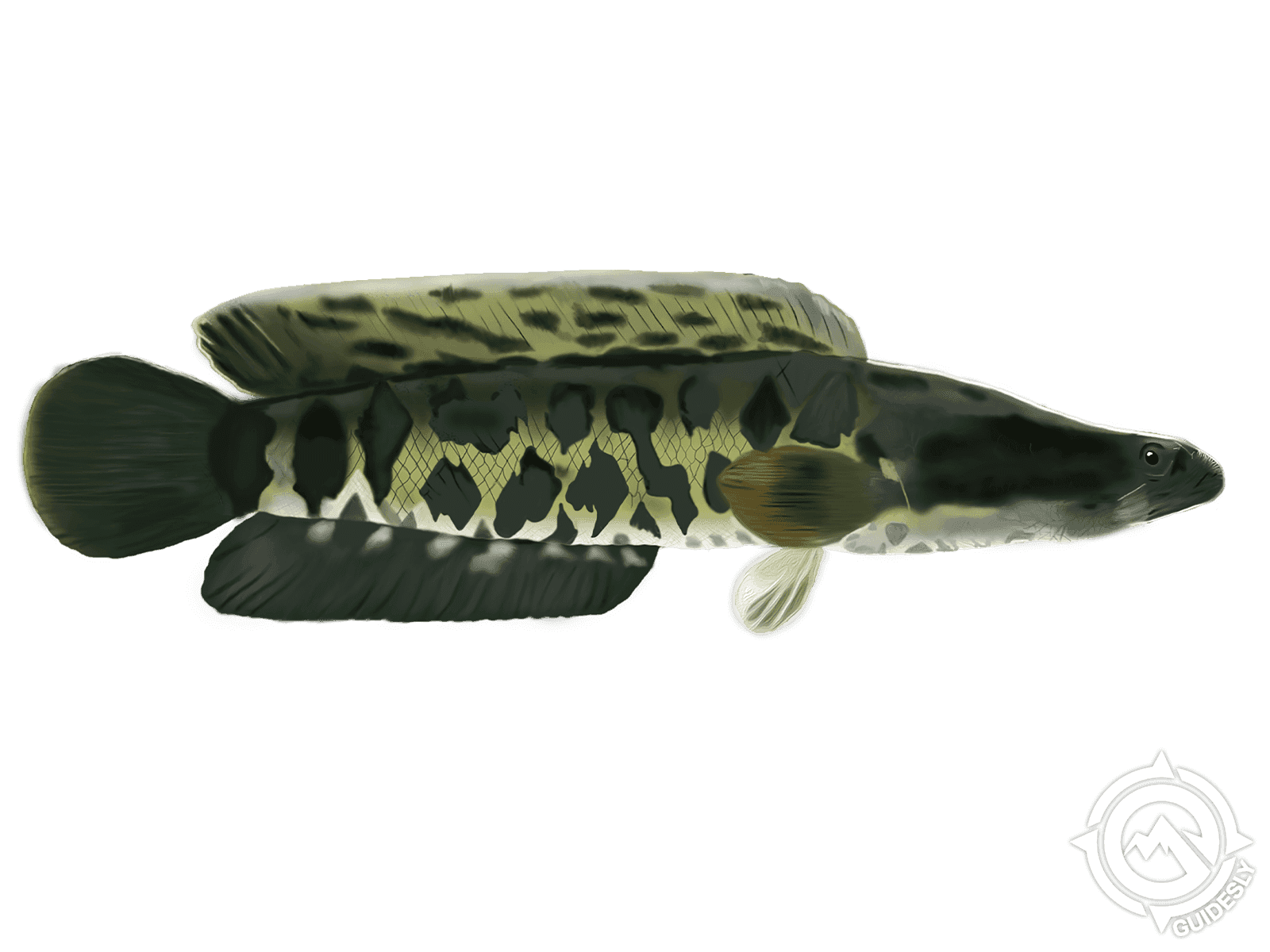Great Snakehead

Species Details
Channa Marulius
Channidae
Perciformes
Lakes, Reservoirs, Canals, Swamps, Rivers
4 - 15 lbs.
18" - 72"
Great Snakehead (Channa marulius) Description
The great snakehead is an air-breathing fish with dark red eyes and a flattened, elongated body. There is a rose-like pattern of scales on its head similar to the epidermal scales on snakes. Juveniles are colorful with dark patches along the sides and as it matures, changes to dark blackish-brown with black blotches with reddish-orange markings.
Near the base of its tail, the great snakehead has an orange and black eye-spot or ocellus that resembles a “bullseye”. This marking can cause misidentification with the Emperor Snakehead and the North American bowfin. It has a long anal fin and pectoral fins that are half the length of its head. All of its fins are pale with a reddish shade. The mouth is large with 7-18 canines behind a row of villiform teeth in their protruding, scaleless lower jaw.
Diet and Size
The great snakehead is a successful predator that has a diverse diet. They prey on fish, crustaceans, gastropods, larval insects, non-biting midges, frogs, snakes, tadpoles, earthworms, small water birds, snakes, turtles, and even rodents.
This species is the largest fish and fastest-growing of the Channidae family. On average, the great snakehead is 18 inches long, weighing 4 pounds. In India, it’s more common at lengths of 47 inches and can grow up to 72 inches long. The IGFA All-Tackle record is at 15lb 2 oz caught in Florida, USA.
Interesting facts about the Great Snakehead
- Great snakeheads are part of 34 documented species that are difficult to distinguish because of similar physical attributes
- They breathe air with a pair of suprabranchial chambers lined with respiratory epithelia
- They can survive out of the water for days as long as their skin is moist
- In Asia, these fish are proclaimed to have medicinal benefits when consumed
- In Indian provinces, it's cultured in ponds, ricefields, and irrigation wells.
How to Catch a Great Snakehead
When it’s not hunting, the great snakehead hovers in midwater and only moves to surface for air. It’s a bottom-dwelling ambush predator that hides behind submerged vegetation or hanging foliage hanging.
Dubbed as a “Super Bass”, fishing for the great snakehead is like fishing for smallmouth bass or rock bass. A good rig would be a 7-foot medium-heavy bait-casting rod with spinning or casting reel, spooled with 15-40lb braid, and a monofilament leader. Using braid allows for stronger hooksets, better presentation, and less chafing. Pliers will be needed to unhook the fish since it has sharp teeth.
Lures are more effective during the warmer peak seasons from mid-march through April. With a similar diet to largemouth bass, the great snakehead will be attracted to topwater lures such as frogs, plugs, poppers, buzz-baits, chatterbaits, spinnerbaits, swimbaits, skirted jigs, musky bucktails, and paddletails.
Live bait works best during the cooler months and the great snakehead will bite almost anything that’s moving. Mummichog, minnows, shad, frogs, crayfish, worms, and other small fish will be effective. Adding a slipfloat would better anglers’ chances, but would depend on the depth of water.
Some anglers hunt for it with colored lines at night when they come closer to the shores. Swampy edges can be prime spots, but there is more vegetation for them to hide in, so steep shoreline banks are better spots to find them. Still-fishing from a boat or casting from the shore in shallower waters can stealthily get you close into this fish’s hiding places.
Habitat and Distribution
The great snakehead is a widespread fish that prefers freshwater with stagnant or slow-moving currents such as lakes, reservoirs, canals, swamps, and deep pools in rivers. It dwells in sandy or rocky bottoms and submerged or overhanging vegetation.
It spawns from March to May and during August to November. It builds floating nests where eggs hatch within 48 hours. The young will stay there for ten days and will be guarded by the parents for a month.
The great snakehead's native range includes India and is fished commercially in Lake Jasiamand. It’s a game fish in Thailand, where it lives in Bang Na lake, The Queen Sirikit Dam, and Mae Ngat Reservoir. Other native regions include Pakistan, Malaysia, Laos, Cambodia, Sri Lanka, Bangladesh, Myanmar, China, and Nepal. In the United States, it’s an introduced species, found only in river and canal systems in southern Florida.






